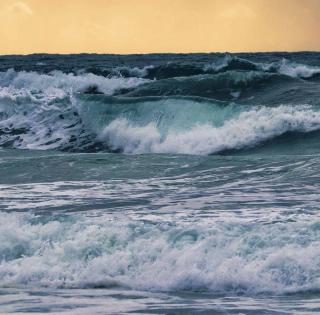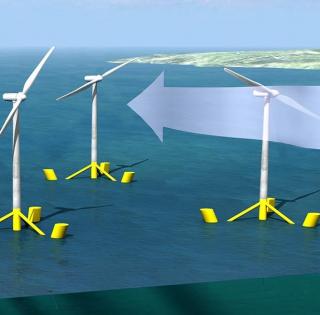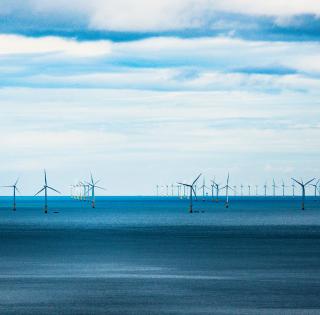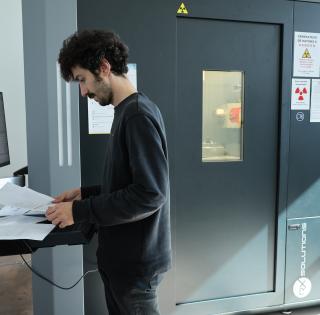
Well established in Europe, offshore wind power could reach more than 100 GW worldwide by 2030, including 10% floating wind power.
By locating floating wind farms in deeper water areas further from the coast (50 to 300 m deep), it will be possible to operate offshore sites where the available wind potential is up to four times higher than for fixed turbines. This is accompanied by a scramble to optimize the ability of offshore farms in order to withstand severe marine conditions and the economic performance of this blue electricity.
Researchers in mechanic engineering at ENSTA Bretagne's IRDL (Dupuy de Lôme Research Institute) lab, are participating in research programs initiated by France Energies Marines as part of future investments "France 2030", with multiple goals such as specifying the magnitude of the dynamic stresses submerged systems are subjected to or predicting their in-service durability. The studies focus on the anchor lines that maintain the wind turbine's position at sea, the dynamic cables that conduct the electricity to the shore and the strength of masts subjected to the repeated impacts of breaking waves.
Characterize the performance of twisted nylon fibers
Measure and monitor their ability to withstand severe conditions
Characterize the ability to withstand the impacts of breaking waves
(1) use flexible polyamide (stranded nylon) mooring lines with durable performance
The industrial goal
France Energies Marines*: "Anchoring systems used for floating wind turbines differ significantly from those used in the oil & gas sector due to elevated dynamics in shallow waters. The challenge is to be able to maintain a floating foundation in an extreme environment by limiting the forces transmitted by the mooring lines as well as limiting the maximum offset of the foundation to which the export cable is connected. One envisaged solution is to use nylon mooring lines capable of absorbing the involved forces, but whose behavior is highly non-linear and poorly understood in cases of long service life."
The studies carried out
- Initially, and in addition to Ifremer's aging studies, the ENSTA Bretagne-IRDL team carried out an innovative, promising study intended to quickly measure the fatigue of these cables in water, through infrared cameras. The aim was to accurately characterize the long-term dynamic behavior of these mooring lines made of twisted nylon yarns (nylon strands). Conducted from 2017 to 2020, this project (Polyamoor) measured the fatigue durability of nylon cables and their deformation (creep) under tension over a period of 2 to 3 years. These results allowed a behavioral law to be defined for this type of cable, which can now be used in a calculation code for the simulation of floating wind turbines ("Deeplines" code).
This research was carried out as part of Yoan Chevillote's thesis defended in 2020: "Characterization of the long-term mechanical behavior and the durability of polyamide mooring ropes for floating wind turbines (MRE)".
- A second stage is under way (Monamoor project, from 2020 to 2024). It aims to increase the understanding of the degradation mechanisms of these continuously immersed nylon lines, in order to develop mechanical modeling tools and to determine appropriate monitoring instruments.
Several specific, additional studies are being carried out to qualify the effects of loading and overloading (storms) in terms of fatigue (strength over time) and creep (deformation), to estimate the fatigue properties related to contact and abrasion phenomena, and finally to model the cyclic, long-term behavior of the anchor lines (failure and loss of the initially installed tensions).
The modeling study is therefore focused on understanding the complex mechanisms within the cross-section of this type of cable (deformations, tensions and friction at the strand level), and predicting the friction over 20 years. This is one of the key parameters of fatigue. A test campaign lasting several months will allow this numerical model of mechanical behavior to be confirmed.This is the subject of Laure Civier's thesis started at the end of 2020: "Monitoring of polyamide mooring lines for offshore wind turbines".
(2) ensure the ability of the dynamic cables that conduct the electricity to the shore to withstand severe conditions
The industrial goal
France Energies Marines*: "Dynamic submarine cables, required to export the electricity generated by all floating ORE systems, are critical components subject to different and much more varied constraints than their static counterparts. Their in-service monitoring is therefore of paramount importance. Some technologies are used for monitoring subsea cables (DTS, DAS, Partial Discharge, etc.), but they have limitations and may not be the most suitable for in-operation monitoring of dynamic cables."
The studies carried out
As part of a larger national program aimed at sizing and monitoring submerged power cables, a consortium has been formed (DYNAMO project, 2020-2022) and is focusing on techniques for monitoring dynamic cables, with the aim of eventually proposing a set of tools and methods for the preventive maintenance of these cables.
The research project has two main scientific goals:
- establish recommendations to optimize in-service monitoring solutions for submerged cables, on the farm scale (from the offshore farm to the shore)
- provide a roadmap for developing identified promising technologies.
ENSTA Bretagne-IRDL is involved in identifying and prioritizing the failure modes of dynamic cables, induced by mechanical or thermal loads.
Mechanical tests are carried out to assess the suitability of cable fault detection techniques. These involve fatigue tests on complete cables subjected to a 3-point bending load. Various measurement techniques have been used to account for the occurrence and propagation of defects in cables (based on acoustic emission, fiber optic measurement and reflectometry). In addition, fracture surface analysis work is to be carried out to identify the failure scenarios of the cables tested.
This work is part of Issam BENCHEIKH's post-doctorate on "Failure modes and instrumentation of dynamic submerged cables" started in February 2021, over a period of 24 months.
(3) Characterize the impacts of waves breaking on floating wind turbines, in order to size these platforms
The industrial goal
France Energies Marines* : "When designing offshore wind turbines for a specific site, the industry has to analyze the Ultimate Limit State (ULS) of the structure, i.e. the maximum expected response that the offshore wind turbines will experience over its lifetime. In the assessment of the ULS, the effects of energetic steep or breaking waves (hereinafter ESBW) are thought to be responsible for considerable uncertainties. As well documented in the oil and gas or fixed offshore wind turbines literature, ESBW may excite the first structural modes (the so-called ringing in presence of steep non-breaking waves), cause damages due to vertical water excursion (run-up) or submersion of the platform (green water) or local deteriorations due to slamming loads. Numerical modelling of a full-scale floating offshore wind turbines (FOWT) even showed that the blade tips could hit the water in presence of realistic ESBW."
The studies carried out
- In cooperation with IFREMER, ENSTA Bretagne-IRDL (DIMPACT project) is preparing to set up a test campaign in an ocean basin. It will measure the forces induced by the impact of breaking waves on the mast of a floating wind turbine. The data obtained will confirm the tool for calculating the most extreme loads that a floating offshore wind turbine must be able to withstand (calculation of the "ultimate limit state").
- In order to improve the formulation of the hydrodynamic forces that are applied to the mast of an offshore wind turbine during breaking waves, best practices have been established regarding the hydrodynamic impact forces within the Wagner theory.
- For this project, ENSTA Bretagne-IRDL is supervising the research engineer Paul Renaud and Florian Hulin's thesis that started at the beginning of 2021: "Hydrodynamic loads induced by wave impacts on floating wind turbines."
* The background information on the industrial goals is taken from the France Energies Marines (FEM) website: france-energies-marines.org
Further information on the industrial goals and partners of these projects:
- Mooring lines: POLYAMOOR project(2017-2020, 6 partners, supported by Naval Energies and FEM), monitoring of the MONAMOOR project(2020-2024, 13 partners, supported by Ifremer and FEM)
- Electricity conducting cables: DYNAMO project (2020-2024, 8 partners, supported by EDF and FEM)
- Impact of breaking waves on masts: DIMPACT project (2020-2023, 17 partners, supported by FEM)





















